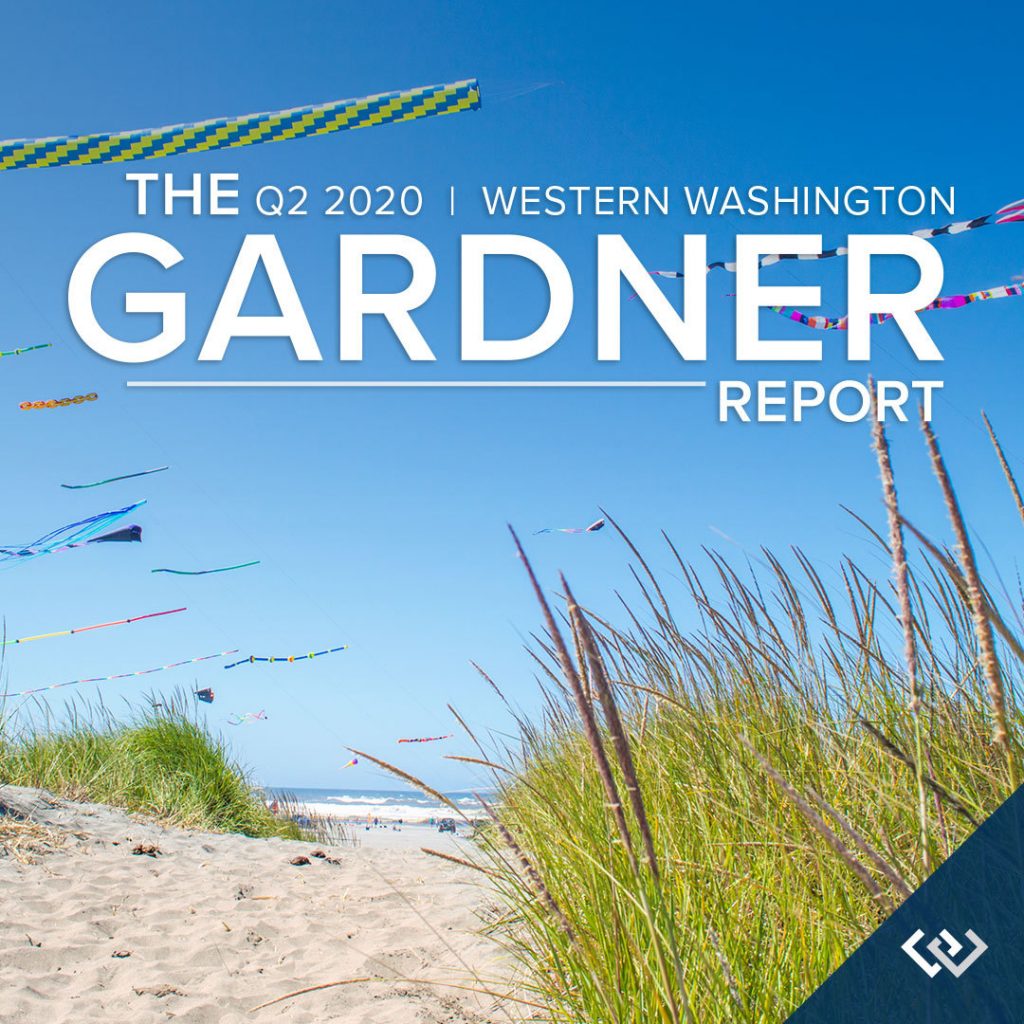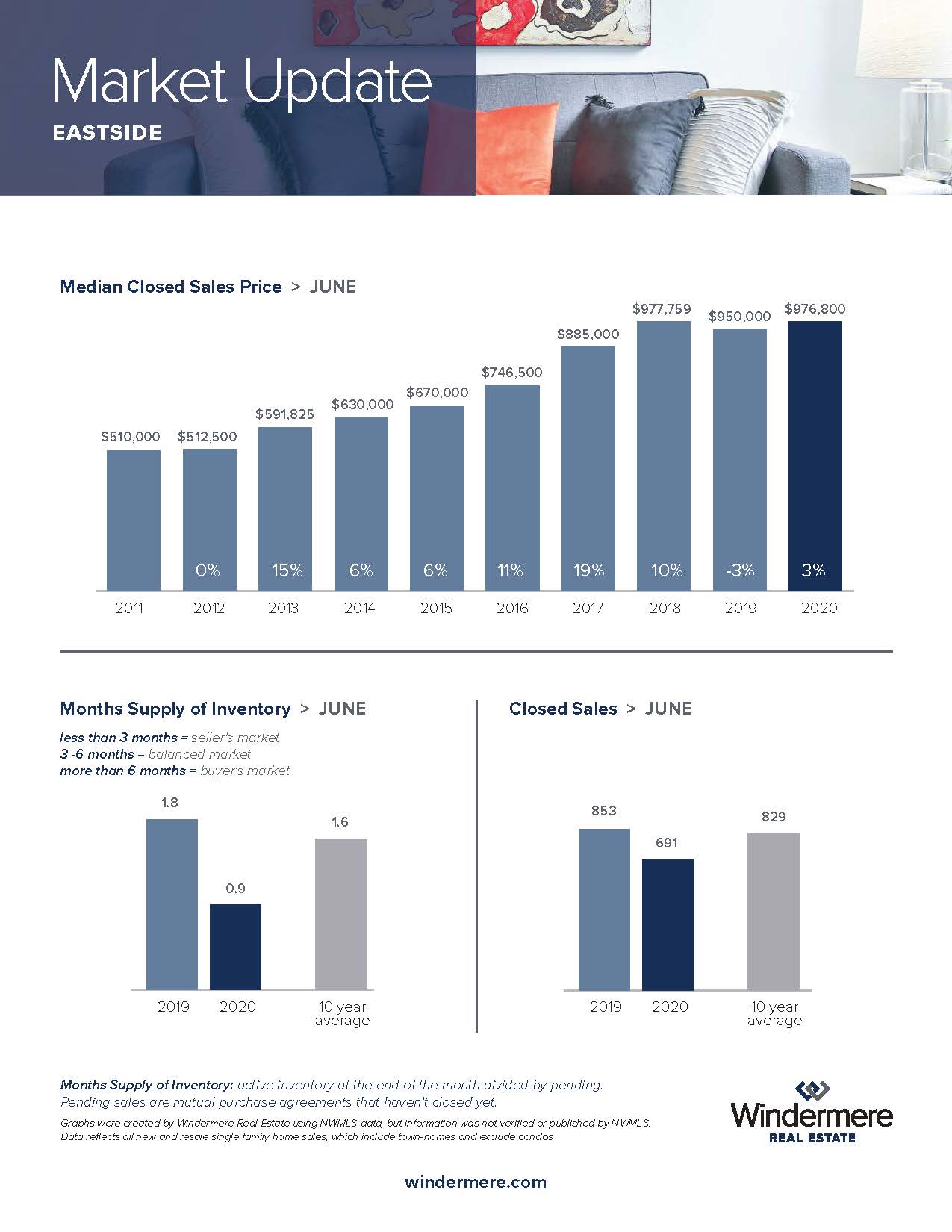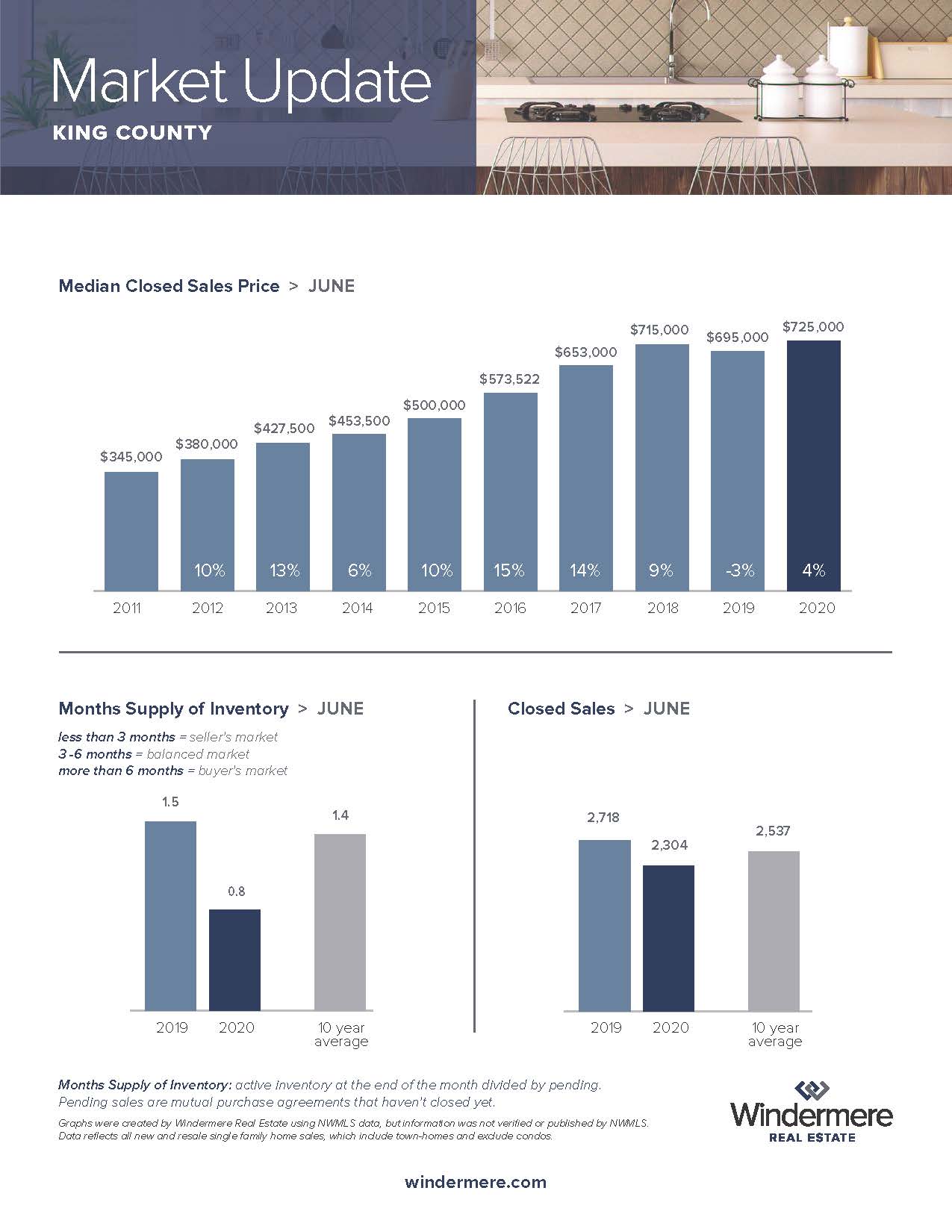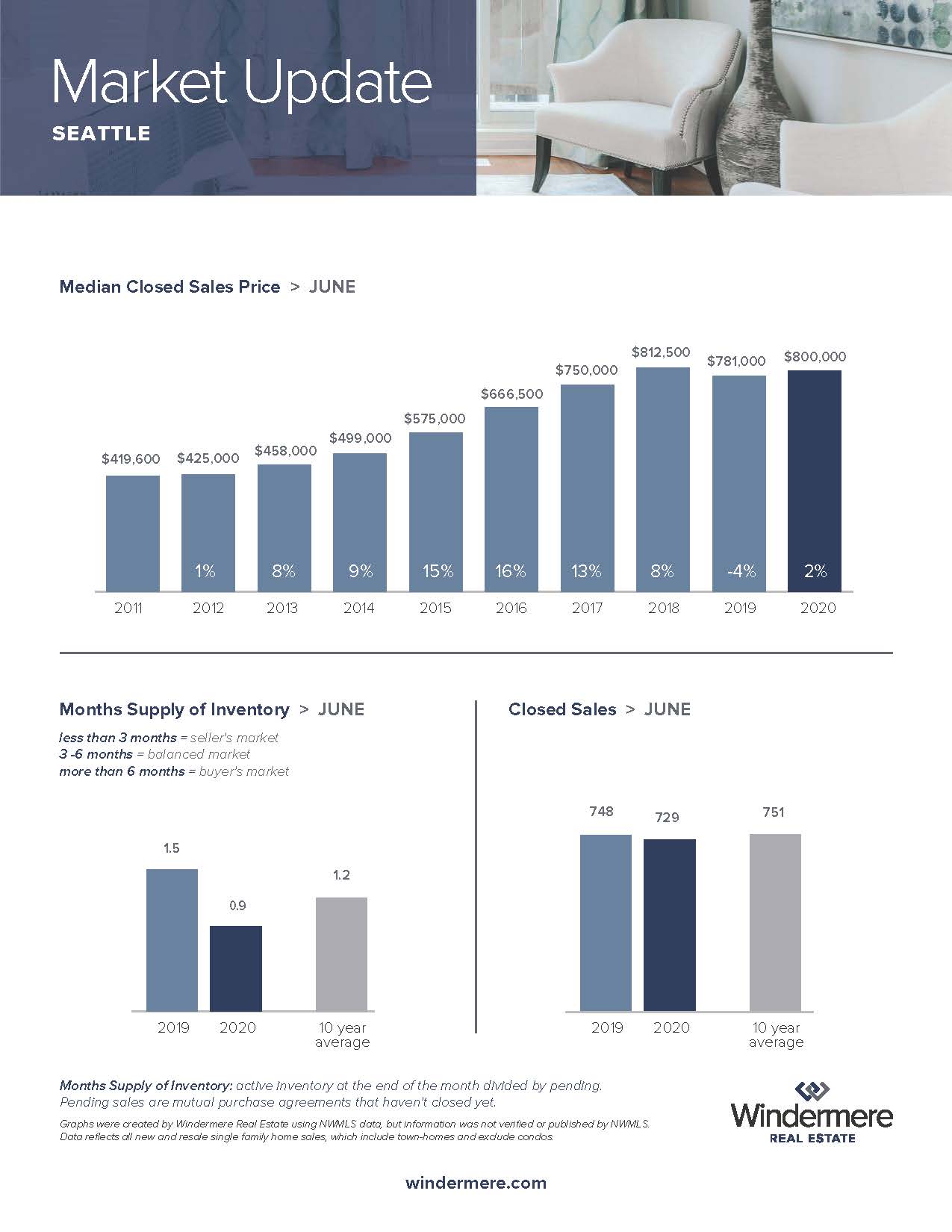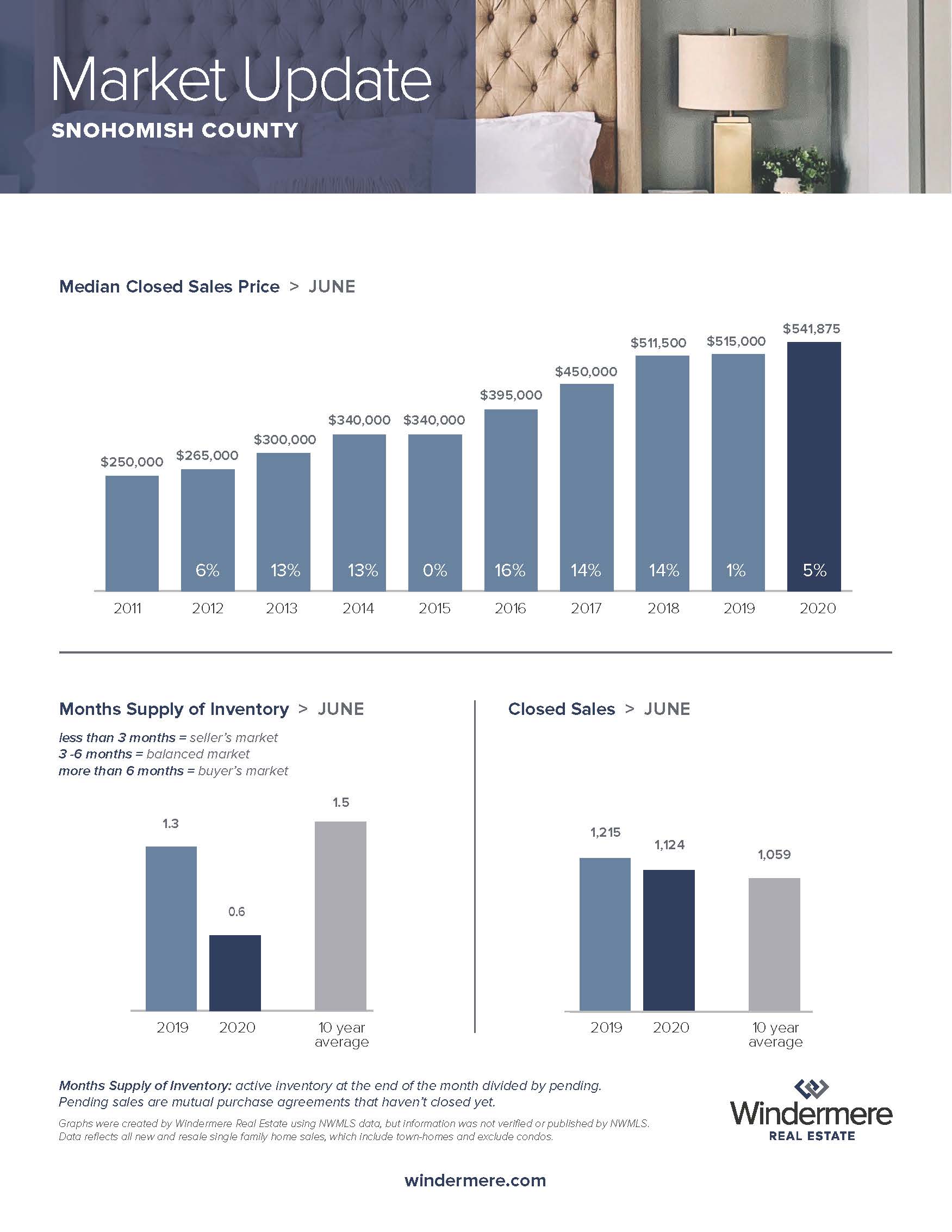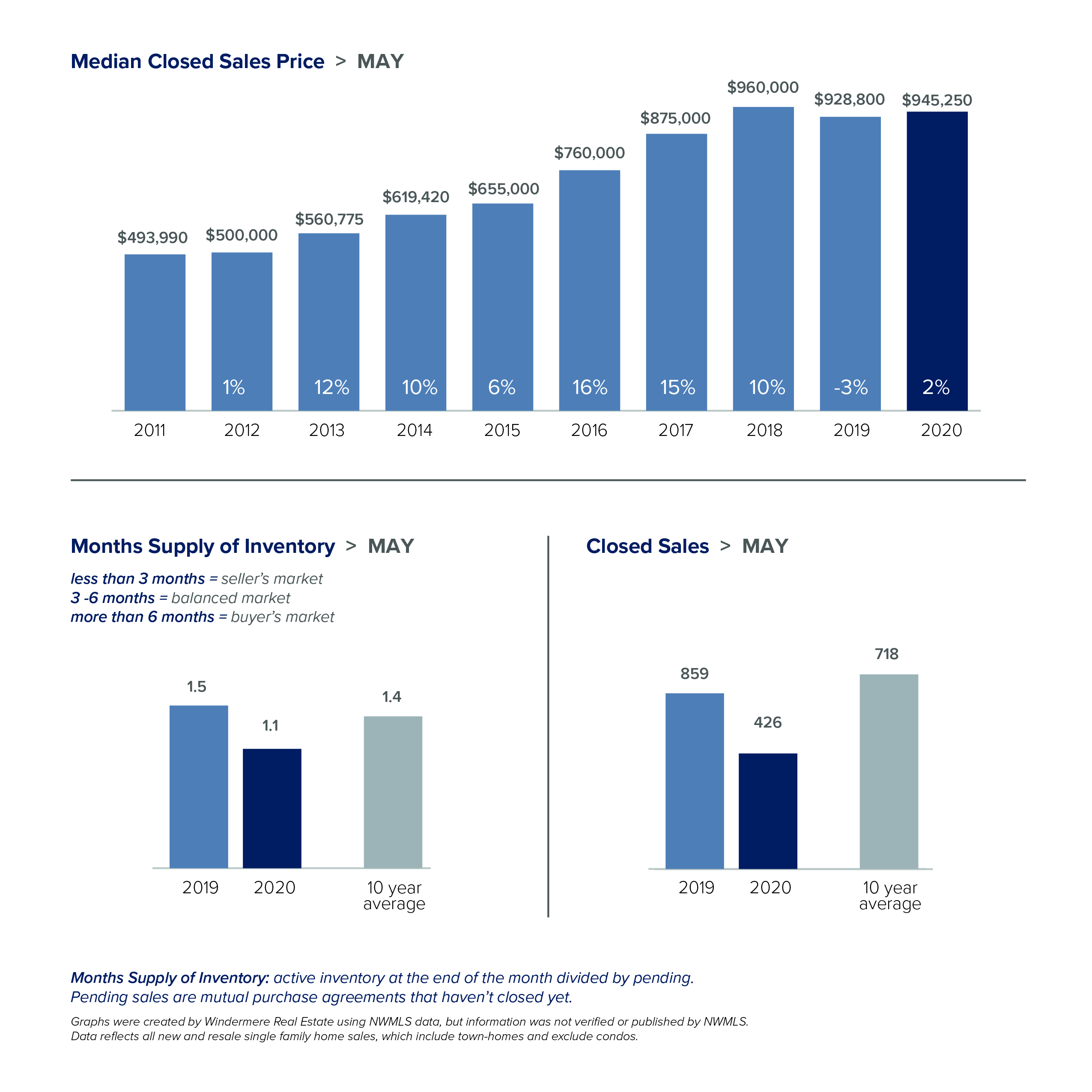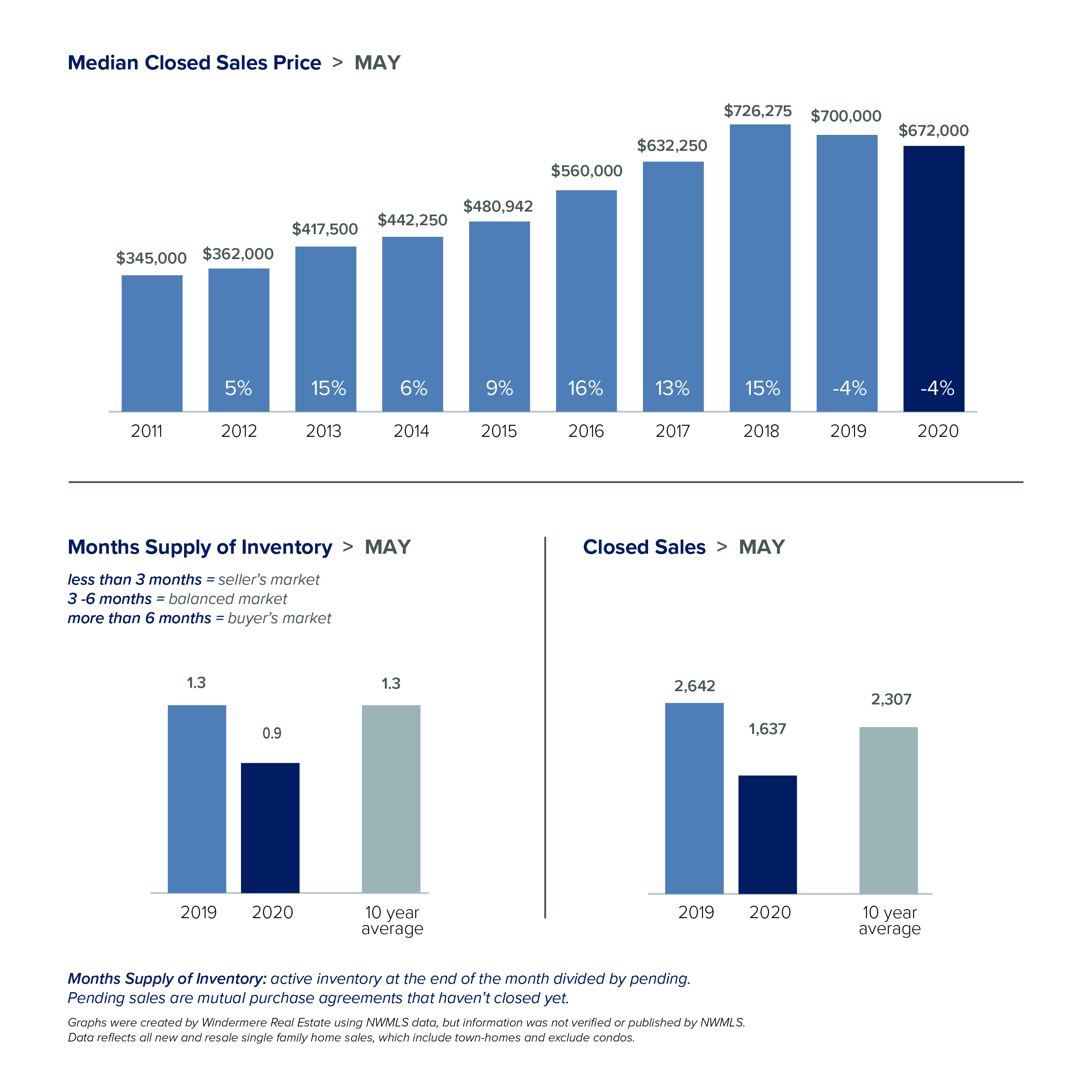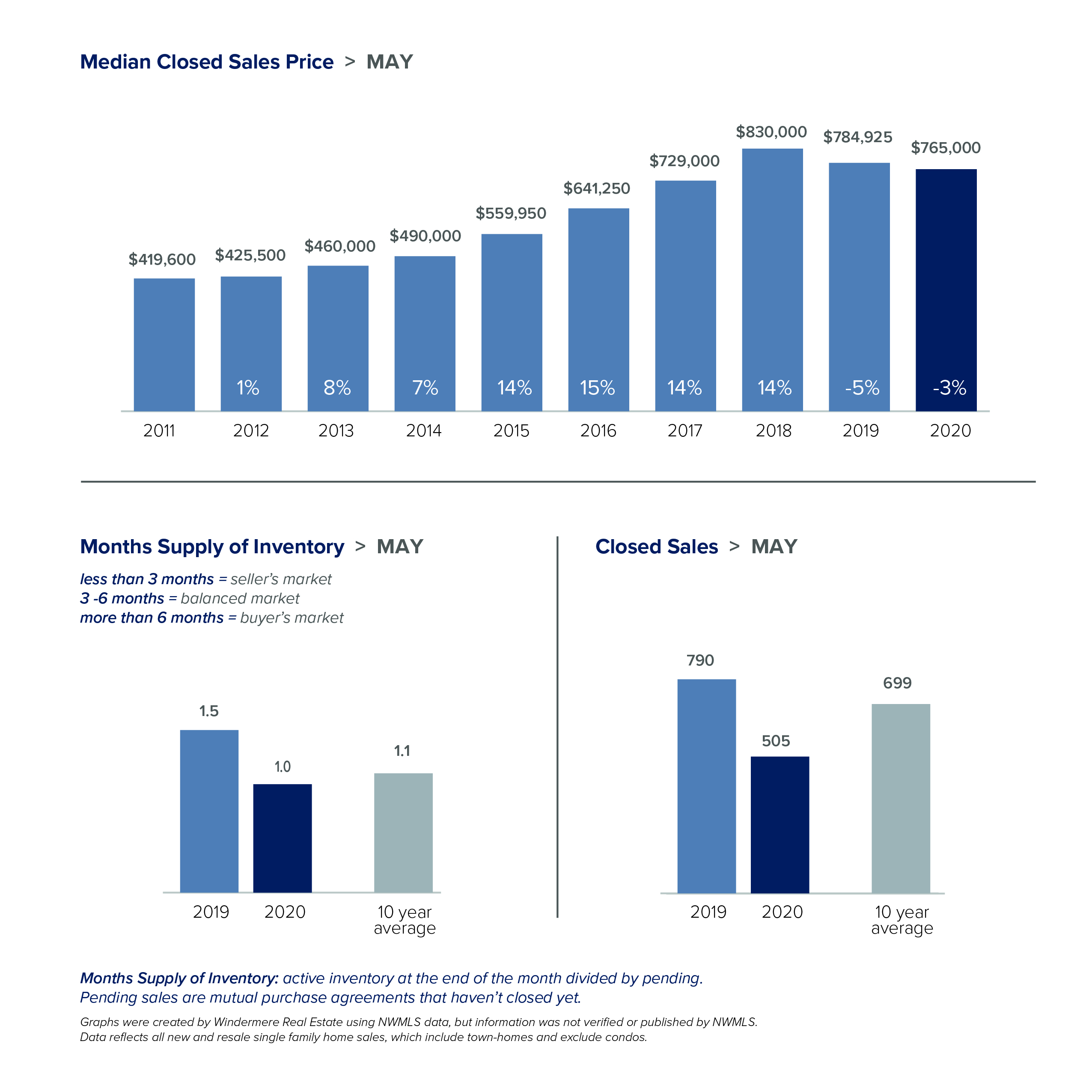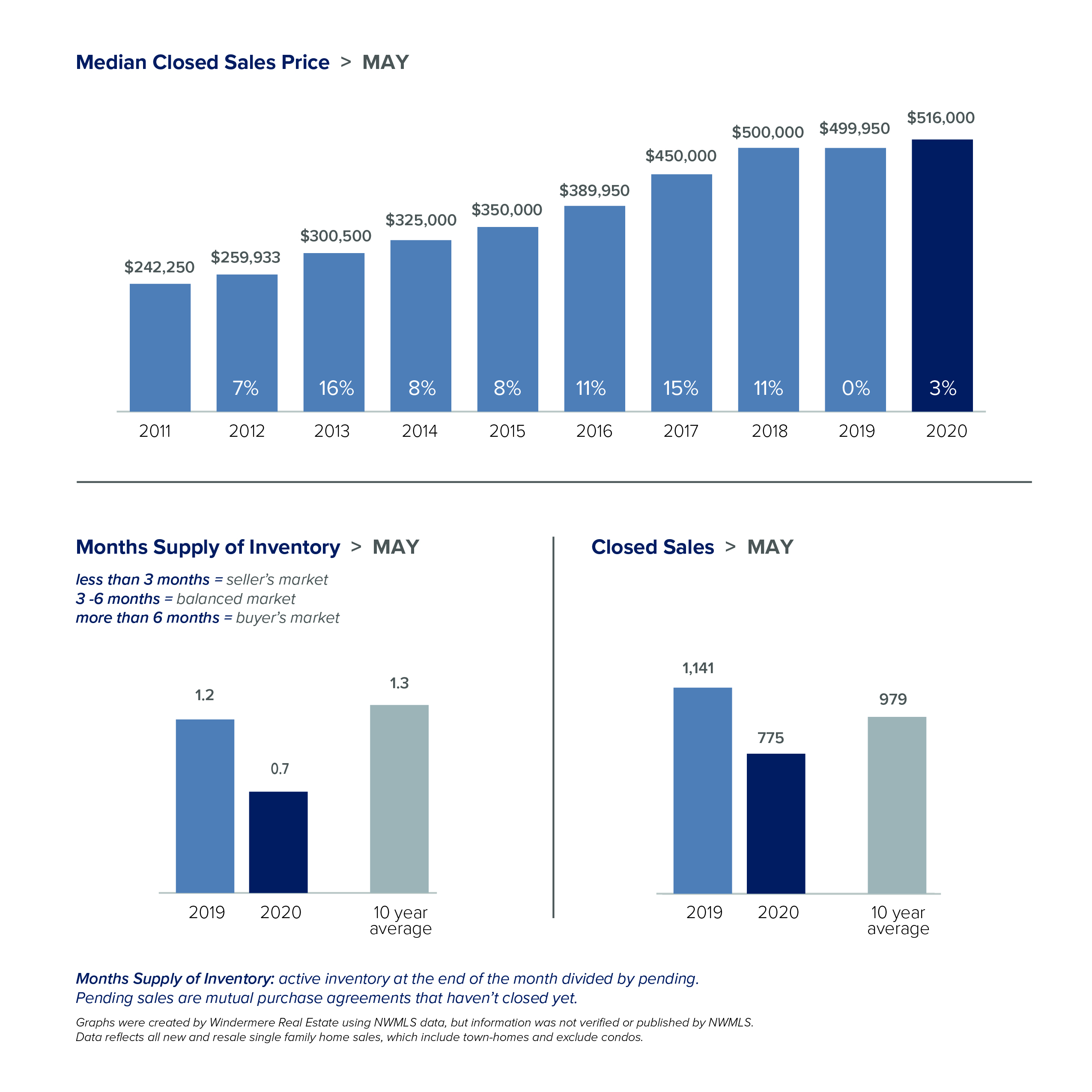Updated Housing Forecast July 2020
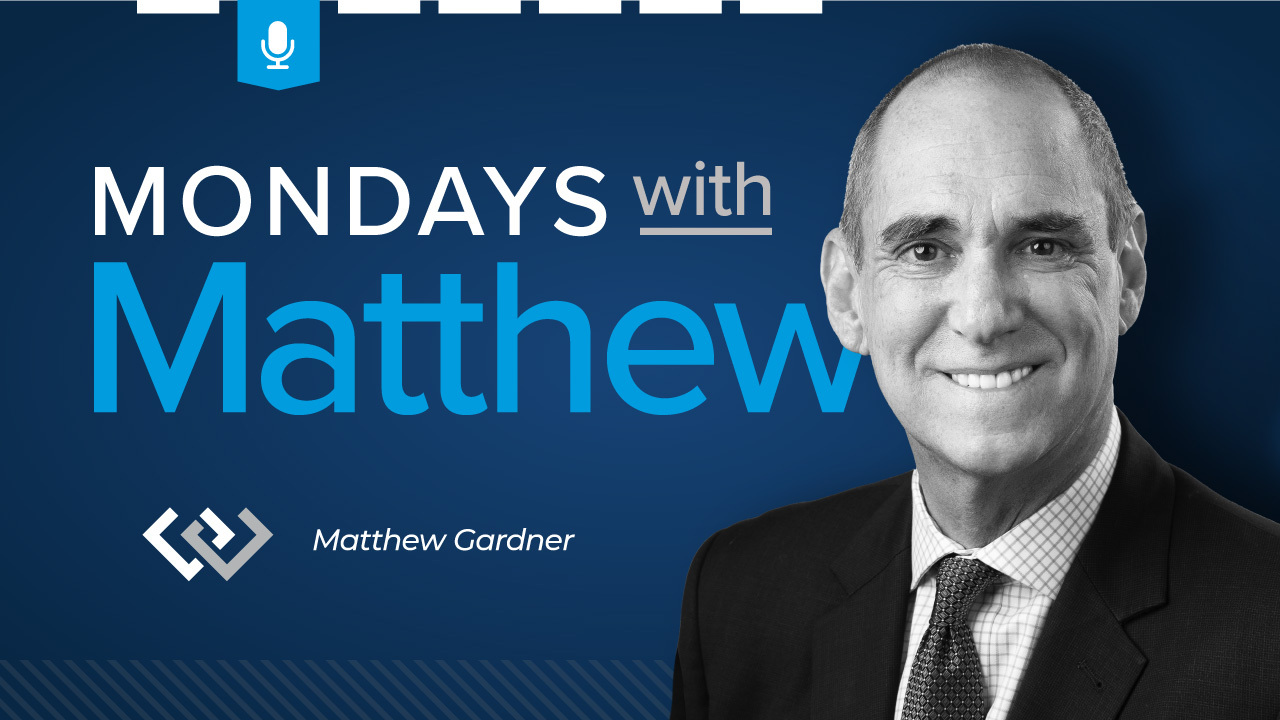
Gardner Report Western Washington Q2 2020
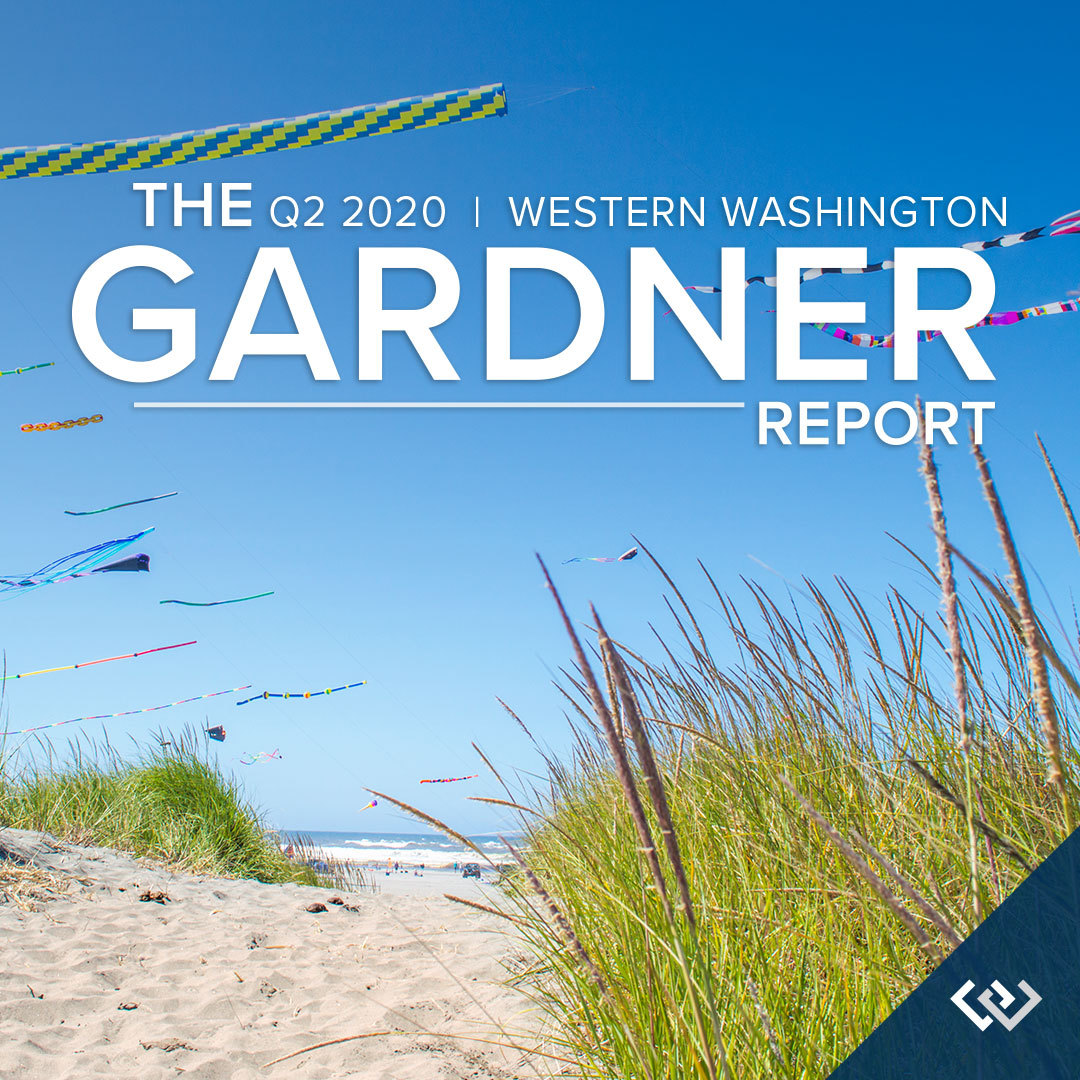
The following analysis of the Western Washington real estate market is provided by Windermere Real Estate Chief Economist Matthew Gardner. We hope that this information may assist you with making better-informed real estate decisions. For further information about the housing market in your area, please don’t hesitate to contact your Windermere agent.
REGIONAL ECONOMIC OVERVIEW
It appears as if the massive COVID-19 induced contraction in employment that Washington State — along with the rest of the nation — experienced this spring is behind us (at least for now). Statewide employment started to drop in March, but April was the real shock: total employment dropped almost 460,000 between March and April, a decline of 13.1%. However, this turned around remarkably quickly, with a solid increase of 52,500 jobs in May. Worthy of note is that, in May alone, Western Washington recovered 43,500 of the 320,000 jobs that were lost in the region the prior month. Although it is certainly too early to categorically state that we are out of the woods, the direction is positive and, assuming we respect the state’s mandates regarding social distancing and mask wearing, I remain hopeful that Washington will not have to re-enter any form of lockdown.
HOME SALES
- There were 17,465 home sales during the second quarter of 2020, representing a drop of 22.2% from the same period in 2019, but 30.6% higher than in the first quarter of this year.
- The number of homes for sale was 37% lower than a year ago, but was up 32% compared to the first quarter of the year.
- Given COVID-19’s impacts, it’s not surprising that sales declined across the board. The greatest drops were in Whatcom and King counties. The smallest declines were in Grays Harbor and Cowlitz counties.
- Pending sales — a good gauge of future closings — rose 35.7% compared to the first quarter of the year, suggesting that third quarter closings will grow as well.

HOME PRICES
- Home-price growth in Western Washington rose by a relatively modest 3.5% compared to a year ago. The average sale price in the second quarter was $559,194.
- Compared to the same period a year ago, price growth was strongest in Grays Harbor County, where home prices were up 14.3%. Clallam County also saw a double-digit price increase.
- It was interesting to note that prices were up a significant 6.6% compared to the first quarter. This suggests that any concern regarding negative impacts to home values as a function of COVID-19 may be overblown.
- I will be watching for significant price growth in less urbanized areas going forward. If there is, it may be an indication that COVID-19 is affecting where buyers are choosing to live.

DAYS ON MARKET
- The average number of days it took to sell a home in the second quarter of this year matched the second quarter of 2019.
- Across the entire region, it took an average of 40 days to sell a home in the second quarter. I would also note that it took an average of 14 fewer days to sell a home than in the first quarter of this year.
- Thurston, King, Pierce, and Snohomish counties were the tightest markets in Western Washington, with homes taking an average of only 17 days to sell. All but two counties, Grays Harbor and Cowlitz, saw the length of time it took to sell a home drop compared to the same period a year ago.
- Market time remains well below the long-term average across the region. This is due to significant increases in demand along with the remarkably low level of inventory available.

CONCLUSIONS
 This speedometer reflects the state of the region’s real estate market using housing inventory, price gains, home sales, interest rates, and larger economic factors.
This speedometer reflects the state of the region’s real estate market using housing inventory, price gains, home sales, interest rates, and larger economic factors.
What a difference a quarter makes! Given that demand has reappeared remarkably quickly and interest rates remain historically low, it certainly remains a seller’s market and I don’t expect this to change in the foreseeable future.
The overall housing market has exhibited remarkable resilience and housing demand has rebounded faster than most would have expected. I anticipate demand to remain robust, but this will cause affordability issues to remain as long as the new construction housing market remains muted.
ABOUT MATTHEW GARDNER
 As Chief Economist for Windermere Real Estate, Matthew Gardner is responsible for analyzing and interpreting economic data and its impact on the real estate market on both a local and national level. Matthew has over 30 years of professional experience both in the U.S. and U.K.
As Chief Economist for Windermere Real Estate, Matthew Gardner is responsible for analyzing and interpreting economic data and its impact on the real estate market on both a local and national level. Matthew has over 30 years of professional experience both in the U.S. and U.K.
In addition to his day-to-day responsibilities, Matthew sits on the Washington State Governors Council of Economic Advisors; chairs the Board of Trustees at the Washington Center for Real Estate Research at the University of Washington; and is an Advisory Board Member at the Runstad Center for Real Estate Studies at the University of Washington where he also lectures in real estate economics.
This post originally appeared on the Windermere.com Blog.
Local Market Update July 2020


While our lives are very different than they were a year ago, the local real estate market has recovered to 2019 levels. Record low interest rates are helping spur demand. Sales were up, home prices increased and multiple offers were common.
- The number of pending sales, a measure of current demand, was higher in June than for the same period a year ago.
- The supply of homes on the market remains very low, with just a month of available inventory. When inventory is this low, quick sales over full price are common. That was the case in June when about 40% of homes sold for more than the asking price.
- Home prices in King County rose 4% over a year ago. Snohomish County home prices increased 5%.
- More sellers put their homes on the market. While total inventory remains low, the number of new listings in June was similar to the same time last year.
The monthly statistics below are based on closed sales. Since closing generally takes 30 days, the statistics for June are mostly reflective of sales in May. If you are interested in more information, every Monday Windermere Chief Economist Matthew Gardner provides an update regarding the impact of COVID-19 on the US economy and housing market. You can get Matthew’s latest update here.
EASTSIDE
KING COUNTY
SEATTLE
SNOHOMISH COUNTY
VIEW FULL SNOHOMISH COUNTY REPORT
This post originally appeared on GetTheWReport.com
Local Market Update June 2020


As we move to the next phase of reopening, life feels like it’s slowly inching back towards normal. The same is true in real estate. Statistics on home sales in May provided the first true picture of the effects of COVID-19. Those reports confirmed the incredible strength and stability of the local real estate market.
- The Stay Home order, as expected, continued to impact the number of sales. However, the market is starting to move its way towards more normal activity. Pending sales, a measure of current demand, have risen every week since April.
- The slight drop in median closed sale price is a result of a proportionately larger number of lower priced homes selling than is normal. It should not be interpreted as a decrease in individual home value.
- There were significantly fewer homes for sale in May than the same time last year. With less than a month of available inventory, competition among buyers was intense. Bidding wars and all-cash offers were common.
The monthly statistics below are based on closed sales. Since closing generally takes 30 days, the statistics for May are mostly reflective of sales in April. If you are interested in more information, every Monday Windermere Chief Economist Matthew Gardner provides an update regarding the impact of COVID-19 on the US economy and housing market. You can get Matthew’s latest update here. As we adapt to new phases of reopening, know that the safety of everyone remains our top priority.
EASTSIDE
KING COUNTY
SEATTLE
SNOHOMISH COUNTY
VIEW FULL SNOHOMISH COUNTY REPORT
This post originally appeared on GetTheWReport.com
Organizing Your Home

Image Source: Shutterstock
When organizing your home, knowing where to start can often be the most difficult part. Breaking the process down room-by-room and keeping the following tips in mind will help you get started and keep your home organized in the long run.
Kitchen
Given how much time is spent in the kitchen, it can get disorganized easily. Kitchen countertops are also one of the most frequently touched and used surfaces in a home. Taking items off the counters and storing them on shelving above or below is an effective first step. Open shelves are a great fixture for easy access while preparing and cooking meals. Store the items you use the most here and stow away large tools that you don’t use as often.
A lazy Susan is a must-have for kitchen organization, bringing the back of the cabinet to your fingertips. A great home for kitchen items that are heavy, clumsy or messy, they are highly accessible. Cleaning out a lazy Susan is much simpler than cleaning out cabinets, which frees up shelf space for those items that usually sit out on your kitchen counter.
Living room
A good first step for your living room is to take inventory. See what items can be disposed and what might belong elsewhere in the house. Take time to think about the flow of the room and how you envision foot traffic will interact with the space.
Multifunctionality goes a long way in the living room. Coffee tables, side tables, and ottomans that are designed with more than one purpose in mind will help to declutter. Look for pieces with underneath storage, drawers, or magazine holders.
Bathroom
For both aesthetics and functional storage, open shelving will help take your bathroom to the next level. It provides plenty of room to stow bathroom supplies, towels, toiletries, and brings a more welcoming feel to the space.
This is a great time to go through your bathroom products. Discarding old, expired, and unused items will free up additional space and give the room a cleaner feel. Once you’ve cleaned everything out, take this time to reorganize your medicine cabinet with your newly reduced bathroom inventory.
Bedroom
Keeping your bedroom organized is a matter of maximizing space and minimizing clutter. If you have limited closet space, try placing a garment rack in a corner or against a wall, or store out-of-season clothing items elsewhere. The underside of your bed is useful for storage. Try functional organizers such as bins and roll-out shelving. Using your dresser as a nightstand or your bookshelf as a décor piece will add flair and cut down on clutter as well.
Making the most of the hanging space in your closet is a sure-fire way of keeping it decluttered. Position the most-used items at eye level and stow lesser-used clothes and accessories higher up. Not only does this give priority to your closet which helps you stay organized over time, but it can save you time when getting ready.
Garage
A common tactic for creating storage space in your garage is to go vertical. This will help free up space for your stuff while maintaining the space reserved for your vehicles. The garage is also a good home for large or bulky items that you don’t use every day.
Going room-by-room will help you piece together the look and feel of the organized home you want to achieve. Be comfortable with clearing out a space in order to put it back together the way you have in mind. Sometimes rooms have to get messier before they get organized.
Originally published on the Windermere Blog by Sandy Dodge
A Guide to Mortgage Assistance During COVID-19

For some homeowners who have been financially impacted by the COVID-19 pandemic, there is a high level of concern about paying their mortgage. Fortunately, there are options to aid struggling homeowners from governments, financial institutions, and loan providers. The following information is intended to provide clarity on which financial relief options are available to you during this time.
What are my mortgage relief options?
Newly placed into law, the Coronavirus Aid, Relief and Economic Security (CARES) Act, provides two protections for homeowners with federally backed mortgages:
Your lender or loan servicer may not foreclose on you for 60 days following March 18, 2020. The CARES Act prohibits lenders and/or servicers from beginning a non-judicial foreclosure, or finalizing a foreclosure sale, against you within this time period. While 60 days has passed since this was put into place, it is still important to be aware of in the event that any of these actions were taken against you.
You have a right to request a forbearance for up to 180 days if you experience financial hardship due to the COVID-19 pandemic. You can also apply for a 180-day extension beyond the forbearance period. This does not require submitting additional documentation beyond your claim, nor will you incur additional fees, penalties or interest beyond what has already been scheduled.
Forbearance is…
With forbearance, mortgage servicers and lenders allow you to pause or reduce your mortgage payments for a period of time while you get back on your feet financially.
Different types of loans beget different forbearance options, understanding the differences and which options apply to your loan is key to navigating the forbearance landscape.
Once your income is back to a normal level, contact your loan servicer and resume your payments.
Forbearance is not…
Forbearance is not a means to forgive or erase your payments. Any missed or reduced payments still require payment in the future.
Which relief options do I qualify for?
The first step in discovering your mortgage assistance qualifications is to contact your mortgage provider. If you are unsure of how to get in touch with them, look at your mortgage statement for contact information or see what contact options are available online.
After you have successfully made contact, find out if your mortgage is federally backed. To be eligible for assistance under the CARES act, your mortgage must either be backed federally, or by one of the entities in the list below. These links show the agencies’ current advise and related loan information:
U.S. Department of Housing and Urban Development (HUD)
U.S. Department of Agriculture (USDA)
Federal Housing Administration (FHA)
U.S. Department of Veteran Affairs (VA)
Fannie Mae – Loan Lookup
Freddie Mac – Loan Lookup
For non-federally backed loans, contact your lender or servicer to learn more about their forbearance repayment options.
Today’s financial landscape can be stressful for homeowners, especially those that are struggling to keep up financially. Fortunately, these entities, institutions, and servicers have provided options to help lessen the burden. Knowing which options apply to you and your household will help you navigate through hardship as your finances recover.
Originally published on the Windermere Blog by Sandy Dodge
Black Lives Matter

by Elly McKenzie
At Windermere Bellevue Commons we support our Black neighbors in Bellevue, King County, and around the country. We stand with them against racism and oppression obvious and insidious, interpersonal and infrastructural. We recognize that we serve a community of agents who serve a diverse population of clients; it is our duty to acknowledge the privileges we have been afforded and the duty we have to use that privilege to support our minority communities. Over the last week we have needed to step back and listen to the Black community. Moving forward, we must support the Black community and educate ourselves and our white neighbors of the historic oppression communities of color have faced in this country and specifically in King County through Red-Lining and gentrification.
We are making donations to Black Lives Matter, Black Lives Seattle, Black Resilience Fund, and the ACLU, and encourage you to do the same. We also encourage you to do the work to educate yourselves and take action to make Bellevue, King County, and the United States a more equitable place for everyone. We are working to compile resources where you can support Black owned businesses on the Eastside and in King County. Stay tuned for more information.
Local and National Reading and Resources:
A History of Redlining in Seattle (watch)
Donate or Take Action:
Black Lives Matter-Seattle|King County
Saving in the Laundry Room


Image Source: Shutterstock
When it comes to household expenses, staying at home has brought about savings in some areas, while increasing expenses in others. The laundry room has likely seen an uptick in usage, with its associated costs following suit. Save your energy and money by keeping these tips in mind as we continue to adapt to being home more often.
Master your machine settings
Review the owner’s manuals for your washer and dryer. There may very well be energy-saving settings you’re not using. For example, your washer’s “high-speed” or “extended wash” cycles will remove more moisture, which can help reduce drying time. A dryer’s “cool down cycle” allows clothes to finish drying using only residual heat.
Think twice before washing
Once you’re aware of the costs associated with washing and drying, and the natural resources this consumes, you may decide you don’t need to launder certain clothes as often – which can also extend the life of these garments. Some clothing, like jeans, sweatshirts, and sweatpants, can be worn a few times without a cleaning. Washing these items only when necessary will help you cut down. Another tip – keep another laundry basket in your room for those lightly worn clothes that you could wear again, so they keep separate from your clean clothes.
Use hot water only when necessary
Using warm water instead of hot can significantly cut down your washer’s energy expense. Using cold water puts less pressure on electricity grids, saving your household even more money and energy. Cold water washes are less likely to shrink or fade your clothing as well. To ensure your clothes still get clean, try using a cold-water detergent.
Right-size your loads
For both washing and drying, taking into consideration the size of your load can factor greatly into your savings. No matter the size of the load you wash, it costs the same amount to run a cycle. So instead of doing two small loads, wait until you have one large load. When drying, keep in mind that an overly full dryer will take longer to dry the clothes. A dryer with too few items inside costs more to operate.
Clean the dryer vent and filter
When the lint filter in your dryer gets clogged, airflow is reduced, and the dryer can’t operate effectively. Make a point to clean the filter after every use. If you use dryer sheets, scrub the filter every month to remove any film buildup. The venting that attaches to the back of your dryer also needs to be kept clean and clear.
Air dry
When the weather is sunny and warm, consider putting your clothes out to hang-dry. Doing so will keep your drying expenses to a minimum. It can also be a better drying method for clothing with delicate tailoring.
With staying at home being the new status quo, taking a look at the ways our homes use energy and incur expenses is more relevant than ever. These small changes in the laundry room are just some of the minor adjustments you can make in your household during these unique times.
Originally published on Windermere.com
Local Market Update May 2020
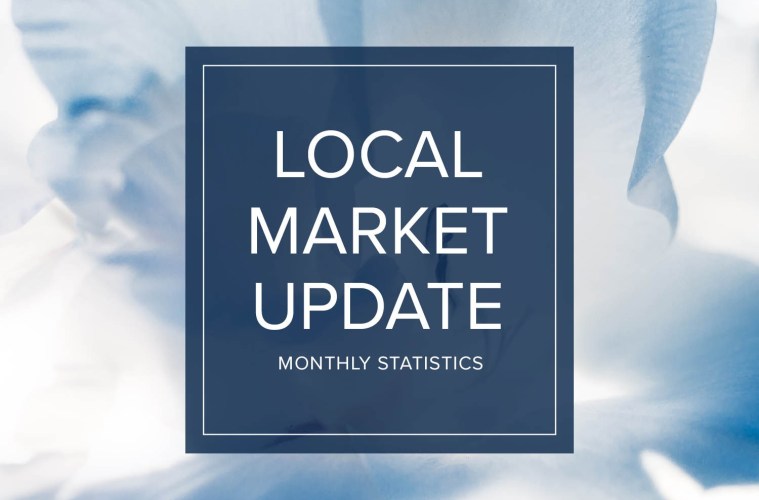
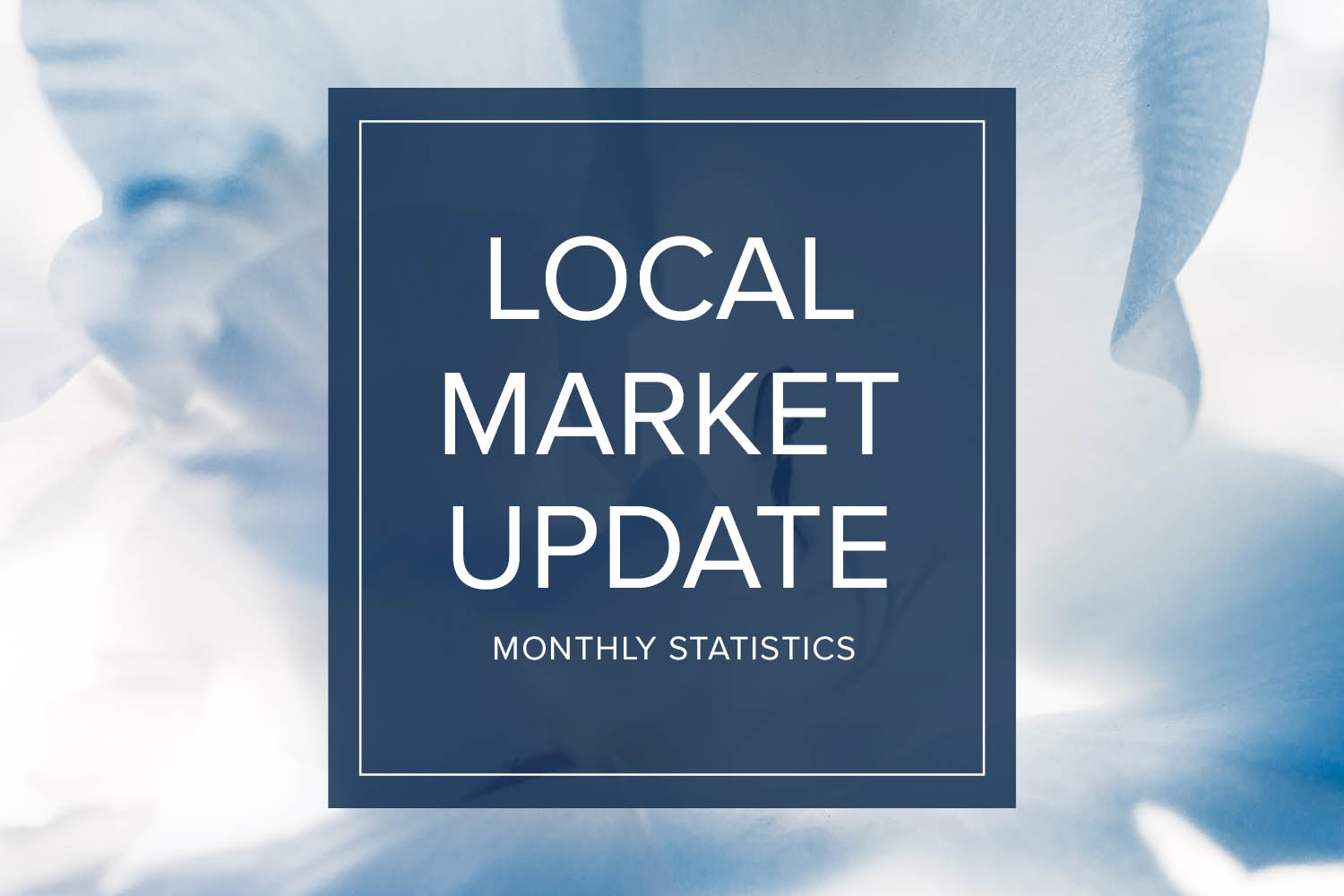
We hope you are weathering the new normal as best as you can. With everyone spending more time than ever at home, real estate has taken on a whole new importance. For those who are interested, here is a brief update on how COVID-19 continues to affect our local market:
- Business was better than expected under the Stay Home order. COVID-19 did reduce real estate sales in April as compared to a year ago, however the number of sales rose steadily each week of the month. Sales growth continued in early May and we expect sales to increase slowly week by week.
- The number of new listings dropped, suggesting that would-be sellers are waiting until the shelter-in-place order is over to put their home on the market. With local technology companies continuing to hire, buyers will continue to face competition for limited inventory in the coming months.
- Home prices remain stable, with the median price of homes sold in April up slightly from a year ago. Sellers appear to be pricing homes realistically and buyers are not finding deep discounts.
The monthly statistics below are based on closed sales. Since closing generally takes 30 days, the statistics for April are mostly reflective of sales in March. Next month’s data will offer a more telling trend of the effect of the virus on the local housing market.
If you are interested in more information, every Monday Windermere Chief Economist Matthew Gardner provides an update regarding the impact of COVID-19 on the US economy and housing market. You can get Matthew’s latest update here.
As our current situation evolves, know that the safety of everyone remains our top priority.
EASTSIDE
KING COUNTY
SEATTLE
SNOHOMISH COUNTY
VIEW FULL SNOHOMISH COUNTY REPORT
This post originally appeared on GetTheWReport.com
Help Us Raise Funds for our Neighbors in Need

Windermere offices have a goal of raising $250,000 for food banks in our community and the Windermere Foundation will match every dollar we raise for our “Neighbors in Need” campaign. The need has never been greater! Let’s all do our part so no one goes hungry. You can help by donating here. https://bit.ly/2KlySJC
 Facebook
Facebook
 X
X
 Pinterest
Pinterest
 Copy Link
Copy Link
